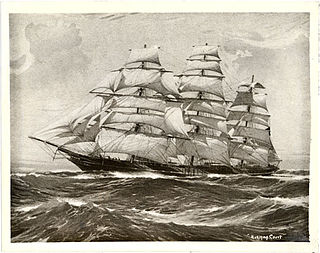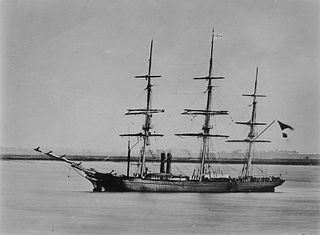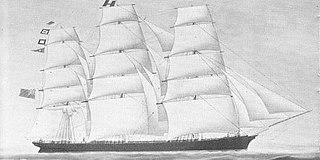
A clipper was a type of mid-19th-century merchant sailing vessel, designed for speed. Clippers were generally narrow for their length, small by later 19th-century standards, could carry limited bulk freight, and had a large total sail area. "Clipper" does not refer to a specific sailplan; clippers may be schooners, brigs, brigantines, etc., as well as full-rigged ships. Clippers were mostly constructed in British and American shipyards, although France, Brazil, the Netherlands, and other nations also produced some. Clippers sailed all over the world, primarily on the trade routes between the United Kingdom and China, in transatlantic trade, and on the New York-to-San Francisco route around Cape Horn during the California Gold Rush. Dutch clippers were built beginning in the 1850s for the tea trade and passenger service to Java.

Thermopylae was an extreme composite clipper ship built in 1868 by Walter Hood & Co of Aberdeen, to the design of Bernard Waymouth of London. Designed for the China tea trade, she set a speed record on her maiden voyage to Melbourne of 63 days, still the fastest trip under sail.

Lothair was a British clipper ship built by William Walker and launched in Rotherhithe, London, on 2 July 1870. After many years of service as a tea clipper, she was operated by merchants in Italy and Peru before being lost in 1910.

Norman Court was a composite built clipper ship, designed by William Rennie, measuring 197.4 ft x 33 ft x 20 ft, of 833.87 tons net. The ship was built in 1869 by A. & J. Inglis of Glasgow. On the night of 29 March 1883 in a strong gale she was driven ashore and wrecked in Cymyran Bay, between Rhoscolyn and Rhosneigr, Anglesey. All bar two of the crew were saved by lifeboats from nearby Holyhead. Andrew Shewan was captain of the Norman Court from her launch until he retired in ill-health in 1873, following an extraordinarily difficult passage from China. His son, also Andrew Shewan, who had previously sailed as first mate, became captain. It was this son Andrew Shewan who recounted many tales of the ship and of the clipper ships in his book Great Days Of Sail: Reminiscences of a Tea Clipper Captain, published in 1926 when he could plausibly claim to be the last surviving tea clipper captain. He died in December 1927.

Sir Lancelot was a clipper ship which sailed in the China trade and the India-Mauritius trade.
Alexander Hall and Sons was a shipbuilder that operated in Aberdeen from 1797 to 1957. They designed the pointed and sharply raked Aberdeen bow" first used on the Scottish Maid and which became a characteristic of the "extreme clippers".
Flying Spur was a British tea clipper, built of teak and greenheart in 1860.

Surprise was a California clipper built in East Boston in 1850. It initially rounded Cape Horn to California, but the vessel's owners, A. A. Low & Brother, soon found that the vessel performed well in Far Eastern waters. From that point onward the vessel spent much of her working life in the China trade, although the vessel also made three trips from the East Coast of the United States to California.

The Memnon was the first clipper ship to arrive in San Francisco after the Gold Rush, and the only clipper to arrive in San Francisco before 1850. Built in 1848, she made record passages to San Francisco and to China, and sailed in the first clipper race around Cape Horn.

Lookout was an 1853 clipper known for her passages from New York to San Francisco, and as an offshore and coastal trader in the lumber and coal trades.

Race Horse was an 1850 clipper barque. She set a record of 109 days from New York to San Francisco during the first Clipper Race around the Horn.

Lahloo was a British tea clipper known for winning the Tea Race of 1870, and finishing second in the Tea Race of 1871. She sailed from Fuzhou to London with over a million pounds of tea in 1868.

Lord of the Isles was the first iron-hulled tea clipper, built in Greenock in 1853. She served in the tea trade until 1862, and also made voyages to Australia. She is known for a record passage between Greenock and Shanghai, and for her close finish in the 1856 Tea Race from China to England, docking in London just ten minutes before Maury. This race was the basis for the plot of a 1927 movie by Cecil B. DeMille The Yankee Clipper.

Windhover was a British tea clipper built in the closing years of construction of this sort of ship. She measured 847 tons NRT. Like the majority of the tea clippers built in the second half of the 1860s, she was of composite construction. She was built by Connell and Co, Glasgow, Scotland in 1868.
Kaisow, a composite clipper, was built by Robert Steele & Company at Greenock and launched on 19 November 1868.

Wylo a composite clipper was built by Robert Steele & Company, Greenock, and launched on 15 April 1869. Robert Steele & Company also built the famous clippers Ariel and Taeping who took part in the great tea race of 1866, and Sir Lancelot another renown clipper ship.

Osaka, A composite barque, built by William Pile, Sunderland, at Yard No. 179 for Killick Martin & Company, the company founded by Captain James Killick and launched on 12 July 1869. William Pile also built Osaka's sister ship Miako, for Killick Martin & Company launched on 15 April 1869.

Scottish Maid was a Scottish packet boat, a two-masted wooden schooner, built at Alexander Hall and Sons' boatyard in 1839 for the Aberdeen Line. She has been described as the first clipper vessel to be built in Britain. Her design of sharp, forward-raked bow, later called the "clipper bow" or Aberdeen bow, pioneered a succession of larger clipper ships with many also built in Aberdeen on Scotland's northeast coast.

The Great Tea Race of 1872 was a regatta, held in 1872 between two "tea clippers" Cutty Sark and Thermopylae.

In the middle third of the 19th century, the clippers which carried cargoes of tea from China to Britain would compete in informal tea races to be first ship to dock in London with the new crop of each season. These races were also known as the races from China. The consignees of these cargoes wanted to be first in the market with this new crop, so they started to offer a "premium" to a ship that was the first to dock in London in that tea season.

















